Project Categories: EPB TBM
Xi'an Metro Line 1 Lot 12
Robbins EPBs excavate beneath Ancient Chinese City
Project Overview
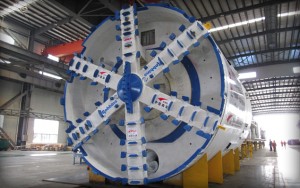 In June and July 2010, commencement of Xi’an’s Metro Line 1 began with the launch of two Robbins machines from Changlepo towards Wanshou Road Station—the first TBMs tunneling on the project.
In June and July 2010, commencement of Xi’an’s Metro Line 1 began with the launch of two Robbins machines from Changlepo towards Wanshou Road Station—the first TBMs tunneling on the project.
Xi’an’s 26.4 km metro Line 1 will run from north to south through the downtown area. Ten TBMs, including two 6.2 m diameter Robbins EPBs, excavated the new rail route. The route travels directly below some of the 3,100 year old city’s most sensitive heritage sites, including the terra cotta warriors.
The Robbins EPBs excavated Lot 12 of Line 1 for the 11th Bureau of China Railway Construction Corporation (CRCC). The parallel 3.6 km tunnels pass through four cut and cover station sites—Changlepo, Wanshou Road, Kangfu Road, and Jinhua Road—under shallow cover ranging from 8 to 22 m. The two TBMs were the first to start excavation on Line 1, and were followed by eight other machines excavating their respective lots.
A total supply contract was signed with China Railway 11th Engineering Bureau Group Limited in June 2009. The second machine assembly was completed in April 2010 at a nearby manufacturing facility in Chengdu before being shipped to the jobsite.
Geology
Both Robbins machines were optimized for geology including sand, abrasive pebbles and clay with significant ground water. Spoke-type cutterheads and 800 mm (32 in) diameter shaft-type screw conveyors aided in efficient advance while maintaining a water-tight seal and balanced pressure.
Tunnel Excavation
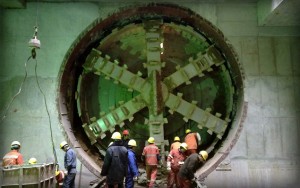 The Lot 12 section was located in a densely urban area, with the tunnels traveling below a college, a hospital, and a marketplace. Crews continuously monitored the excavation rate and overall muck removal volume, by adjusting the thrust force, advance rate, and screw conveyor speed, while keeping the cutterhead speed low, at 1 rotation per minute. Sections of collapsible, water bearing soils were also present in early sections of the tunnel alignment. Crews approached these sections with similar measures, including strict earth pressure control in the mixing chamber, paired with injection of bentonite and water for soil conditioning.
The Lot 12 section was located in a densely urban area, with the tunnels traveling below a college, a hospital, and a marketplace. Crews continuously monitored the excavation rate and overall muck removal volume, by adjusting the thrust force, advance rate, and screw conveyor speed, while keeping the cutterhead speed low, at 1 rotation per minute. Sections of collapsible, water bearing soils were also present in early sections of the tunnel alignment. Crews approached these sections with similar measures, including strict earth pressure control in the mixing chamber, paired with injection of bentonite and water for soil conditioning.
Tunnelling was made even more complex by a city-wide ordinance limiting settlement to ± 15 mm; significantly less than the 25 mm limit that is typical of most Chinese tunnelling projects. The strict settlement guidelines, implemented out of caution due to the ancient structures, required specialized designs for the two Robbins EPBs.
The last intermediate breakthrough, at Jinhua Road station, occurred on July 28, 2011. Advance rates for the Left Line EPB were good—up to 579 m (386 rings) per month and 36 m (24 rings) per day. Planned maintenance was performed while in the cut and cover area, such as changing of cutters and tail seal brushes as well as checkups of the hydraulic system and electrical system. Semi-segment rings consisting of the invert and two segments were installed to allow the machine to ‘walk’ through the 140 m long station site.
Advance rates for the Right Line machine were similarly high—up to 453 m (302 rings) per month and 39 m (26 rings) per day. Settlement was kept below 15 mm with an average settlement of 5 mm.
By summer 2011, one machine had recently completed its second section of tunneling between Wanshou Road and Jinhua Road, and the other was on its last section between Jinhua Road and Kangfu Road in layered loess conditions.
The machines completed tunneling within the project schedule in the last quarter of 2011.
Zhengzhou Metro Line 1
Project Overview
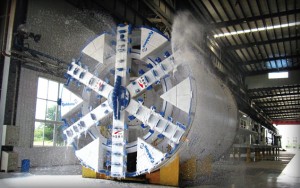 The Zhengzhou Metro consists of twin underground tunnels as part of a larger project for the 11th Bureau of the China Railway Construction Corp. (CRCC) to create the first metro system in the city. Approximately seven million people live in Zhengzhou so the new metro lines will help relieve congestion and allow Zhengzhou to become a center for rail commerce in China.
The Zhengzhou Metro consists of twin underground tunnels as part of a larger project for the 11th Bureau of the China Railway Construction Corp. (CRCC) to create the first metro system in the city. Approximately seven million people live in Zhengzhou so the new metro lines will help relieve congestion and allow Zhengzhou to become a center for rail commerce in China.
The future construction of up to four metro lines is planned for the area, with freight lines between Beijing and Guangzhou (North-South), and Xuzhou and Lanzhou (East-West) intersecting the city. Once complete in 2013, Line 1 of the metro will be 26 km (16 mi) long and include 22 stations. The Zhengzhou Metro Company has invested Yuan 10.2 billion (USD 1.5 billion/EUR 1.1 billion) in the new metro project. Once all lines have been completed – sometime between 2015 and 2030 – the entire metro line will stretch 188 km (117 mi).
Geology
Soft, powdery soils made up the first part of the drive. Line 1 involved excavation under urban areas of Zhengzhou with cover as low as 7 m (23 ft) for almost half the length of the tunnel. The drive also included a section of tunnel just 7.0 m (23 ft) below Xi Liu Lake, with depths of 1.0 to 2.0 m (3.2 to 6.6 ft). The terrain in this section consisted of permeable soil with underground water below the lake fed by vertical leakage, resulting in challenging ground conditions.
Equipment Features
The Robbins EPBs were designed using spoke-type, soft ground cutterheads with tungsten carbide knife-edge bits. The electric, variable speed drives power the cutterheads at 750 kW (1,005 HP), allowing them to rotate at a speed of 0.3 to 2.0 revolutions per minute. To remove liquidized muck, the EPBs are equipped with shaft-type screw conveyors 800 mm (31 in) in diameter, which take the muck to muck cars for extraction from the tunnel. The thrust rate of both EPBs is 36,000kN (8.1 million lb), with a maximum torque of 4,785 kNm (3.5 million lb-ft) and a maximum stroke of 1,950 mm (77 in).
Both machines were designed with active articulation, which allowed them to bore curves on small radii while keeping the segment lining of the tunnel intact. The segment lining was made of reinforced concrete, 300 mm (12 in) thick, in a 5+1 arrangement with each segment 1.5 m in length. To help stabilize the tunnel lining, one-liquid type backfill was injected between the segment lining and the soft ground to fill in temporary gaps and help minimize subsidence.
TBM Excavation
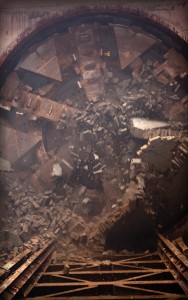 Each tunnel is 3.6 km (2.2 mi) long, passing through four intermediate stations between Kaixuan and Tongbo areas. The machines used on this project were manufactured at Chengdu CSR Tunnelling Equipment Co., Ltd. and launched in November and December 2010. Structural challenges in the low cover tunnel included a highway interchange bridge and building foundations nearby. Foam and bentonite were injected into the soil to improve its condition and reduce settlement. Following the successful completion of these sections, the machines achieved two intermediate breakthroughs into cut and cover sites in early 2011.
Each tunnel is 3.6 km (2.2 mi) long, passing through four intermediate stations between Kaixuan and Tongbo areas. The machines used on this project were manufactured at Chengdu CSR Tunnelling Equipment Co., Ltd. and launched in November and December 2010. Structural challenges in the low cover tunnel included a highway interchange bridge and building foundations nearby. Foam and bentonite were injected into the soil to improve its condition and reduce settlement. Following the successful completion of these sections, the machines achieved two intermediate breakthroughs into cut and cover sites in early 2011.
Line 1 of the Zhengzhou Metro was completed in October and November 2011, at least two weeks ahead of schedule. The two 6.3 m (20.7 ft) Robbins Earth Pressure Balance Machines (EPBs) have set a Chinese EPB record in their size class, excavating up to 720 m (2,362 ft) in one month. Daily advance rates of the machines reached 22 rings (33 m/108 ft) in two 10-hour work shifts. These rates additionally mark a project record compared to nine other machines that worked on the job
Nanjing Metro Line 3 Lot 11 & Line 10 Lot 5
Project Overview
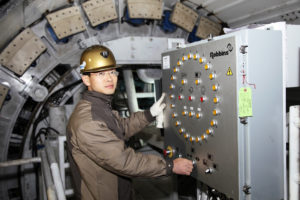 The world-famous Youth Olympic Games were held in Nanjing in summer 2014, bringing 40,000 visitors. This number, combined with the 750,000 people who rode the city’s rails on a daily basis, put the city in need of an extended metro system.
The world-famous Youth Olympic Games were held in Nanjing in summer 2014, bringing 40,000 visitors. This number, combined with the 750,000 people who rode the city’s rails on a daily basis, put the city in need of an extended metro system.
Two new metro lines were built to accommodate the anticipated increase in passengers. Robbins supplied four 6.5 m (21.4 ft) diameter EPBs with mixed ground cutterheads for Line 3 Lot 11 and Line 10 Lot 5, 40.2 km (25.0 mi) and 41.4 km (25.7 mi) long, respectively. The EPBs were part of about 40 TBMs used for the Nanjing Metro expansion.
Ground Conditions
Both lines were bored in soft ground consisting of silty sand, sandstone, small pebbles and man-made materials. The Qinhuai River, old historical structures, a railway and a viaduct were in close vicinity of the lines. Due to the ground conditions and nearby structural constraints, customized excavation methods were employed. The thrust force was kept very low at 6,000 to 9,000 kN (1.4 to 2.0 million lb), continuous monitoring was used to maintain proper alignment and earth pressure, and foam additive was applied to make the ground less sticky and reduce torque.
Excavation
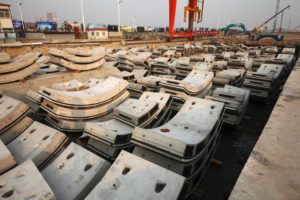 Two of the four 6.5 m (21.4 ft) diameter TBMs were launched for the 2,500 m (8,202 ft) Line 10 Lot 5 in December 2011 and February 2012. The second pair of machines for 2,030 m (6,660 ft) Line 3 Lot 11 began boring soon after in January and March 2012. All machines were assembled and launched from 10 m (33 ft) shafts.
Two of the four 6.5 m (21.4 ft) diameter TBMs were launched for the 2,500 m (8,202 ft) Line 10 Lot 5 in December 2011 and February 2012. The second pair of machines for 2,030 m (6,660 ft) Line 3 Lot 11 began boring soon after in January and March 2012. All machines were assembled and launched from 10 m (33 ft) shafts.
By August 2012, the Line 10 EPBs had excavated 720 m and 600 m (2,362 ft and 1,968 ft), with advance rates of 40 mm (1.6 in) per minute. Over at Line 3, the excavation had progressed as far as 600 m (1,968 ft) with rates topping 60 mm (2.4 in) per minute. Settlement for both lines stayed below the strict required limits of less than 20 mm (0.8 in). By 2013, all four machines had completed their respective tunnels with very favorable results.
The new Lines 3 and 10, now complete, combine with Nanjing’s two existing metro lines to handle the increase in rail riders. The lines will also serve as part of the municipal government’s extensive plan to build 17 new rail routes totaling 600 km (370 mi) across the Yangtze River Basin by 2030.
Moscow Metro
Project Overview
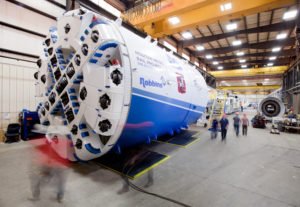 Travel times of over two hours are daily routine for Moscow’s commuters. With a growing population of nearly 12 million, the Moscow Government has issued an extensive city-wide metro project, totaling 50 km (31 mi) of new track by 2018.
Travel times of over two hours are daily routine for Moscow’s commuters. With a growing population of nearly 12 million, the Moscow Government has issued an extensive city-wide metro project, totaling 50 km (31 mi) of new track by 2018.
A total of five Robbins EPBs have bored multiple tunnel drives on the Moscow Metro. Combined, the EPBs have bored more than 8km of tunnel.
Machine Design
All TBMs have been custom designed to handle the area’s complex geology of fine sand, gravel, sandy loam, stiff clays and limestone. Each TBM is equipped with a mixed ground cutterhead capable of switching out carbide cutting tools with disc cutters, depending on conditions.
Besides their mixed ground capabilities, each EPB will utilize a Robbins continuous conveyor system for maximum efficiency during muck removal. Surface monitoring devices will also be employed to limit settlement due to the project’s densely urban environment in the heart of Moscow.
These machines are the first to use electric variable frequency drives (VFDs) in Moscow. The high thrust and torque capabilities of the machines allow for faster excavation while minimizing disturbance that can lead to surface settlement. Active articulation on the machines enables them to excavate tighter curves without the risk of segment deformation that is present when using passive articulation.
Excavation
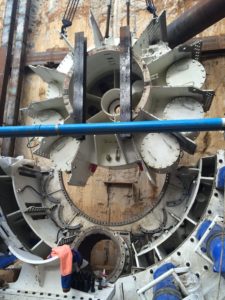 Tunneling occurred at dozens of compact jobsites characterized by Moscow’s challenging mixed ground conditions. Three new Robbins High Performance EPBs and one refurbished machine, named “Julia” operated in various areas of the city. The machines were customized to excavate in the city’s difficult mixed ground geology.
Tunneling occurred at dozens of compact jobsites characterized by Moscow’s challenging mixed ground conditions. Three new Robbins High Performance EPBs and one refurbished machine, named “Julia” operated in various areas of the city. The machines were customized to excavate in the city’s difficult mixed ground geology.
Three Robbins EPB machines were contracted under Engeocom; two 6.6 m diameter machines excavated left and right-hand tunnels, each 1.8 km in length, and “Julia” excavated a 2 km section of a tunnel. A fourth machine contracted under USK MOST is a 6.2 m diameter machine with mixed ground cutterhead that bored a 1.9 km section of a tunnel. All four Robbins machines have also utilized Robbins continuous conveyors for the mixed ground conditions.
When the fourth Robbins machine was launched in winter 2012 from a 15 m deep shaft, contractor USK MOST needed to bore through ground conditions consisting of dense clay and fine sand. They used foam and conditioner to keep the earth balanced, and ultimately for easier muck removal. Not only were they able to keep up with the project’s challenges, but the machine also achieved milestone rates of 150 m in one week, and up to 500 m per month in spring 2013. Experienced crew members, a rigorous schedule, implementation of the continuous conveyor, and the reliability of the Robbins TBM are all factors that helped achieve the record.
Robust Machines, Multiple Drives
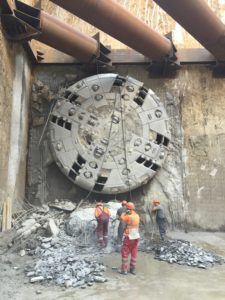 The Robbins EPB for USK MOST made its breakthrough on May 24, 2013. City officials and contractors celebrated not only a record-breaking achievement for the 6.2 m (20.3 ft) diameter mixed ground machine but also finishing ahead of schedule. The TBM achieved a 37.8 m (124 ft) advance in one day at the end of April 2013 – a Russian record for EPBs in the 6 to 7 m (20 to 23 ft) diameter range.
The Robbins EPB for USK MOST made its breakthrough on May 24, 2013. City officials and contractors celebrated not only a record-breaking achievement for the 6.2 m (20.3 ft) diameter mixed ground machine but also finishing ahead of schedule. The TBM achieved a 37.8 m (124 ft) advance in one day at the end of April 2013 – a Russian record for EPBs in the 6 to 7 m (20 to 23 ft) diameter range.
In 2015, a fifth Robbins EPB was added to the mix. The machine was assembled using Onsite First Time Assembly (OFTA) for contractor Evrascon. It bored 4 km of tunnel in hard clay, sand, gravel, pebbles, hard limestone with water, and loam, breaking through in May 2016.
On October 24, 2015, another milestone was reached at the Moscow Metro. A 6.65 m (21.8 ft) diameter Robbins EPB completed its second tunnel, measuring 2.5 km (1.6 mi). The TBM made a breakthrough at its first 2.1 km (1.3 mi) long tunnel drive in January 2014. Contractor SMU Engeocom plans to use the machine on a third tunnel—and that will not be the first time that an EPB has been used on multiple drives at Moscow Metro. Engeocom owns another 6.65 m (21.8 ft) Robbins EPB that completed its second tunnel at the end of September 2015, and will also go on to bore extra tunnels.
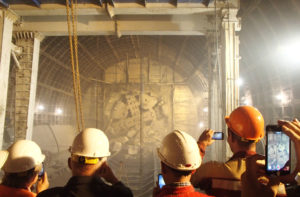
On February 01, 2017 the record-setting Robbins EPB originally for USK MOST started excavation of its fourth bore on the Moscow Metro Project. Its new tunnel will be about 2 km long and will connect stations “Kosino” and “Ulitsa Dmitrievskogo” on the new “Kozhukhovskaya” metro line. The geology is very difficult in this area and running sands are expected. In addition the machine will drive under existing railway tracks. The machine is currently owned by MIP-Story #1 Company—an affiliate of Mosinzhproekt – Main Contractor and Design Institute on the Moscow Metro Project.
The robust Robbins EPBs are capable of even more mixed ground tunnels for the Moscow Metro.
Recent Posts
- World Tunnel Congress 2024
- Use of a Tunnel Boring Machine on Nepal’s First and Second TBM-Driven Tunnels
- Robbins Double Shield Sets Record in Nepal
- Final Breakthrough at Bahçe-Nurdaği Railway
- Record-Setting Large Diameter Mixed Ground Tunneling in Turkey: The Eşme-Salihli Railway Tunnel

 Close
Close  Menu
Menu 